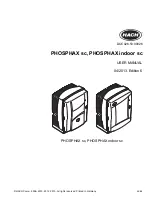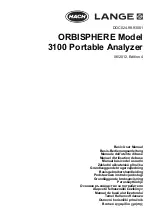
MGL Avionics Stratomaster Ultra Horizon XL Owner’s manual
Page 37
Continue the stable glide for one minute exactly. After the minute has finished, take another
reading of your altimeter.
Example:
VSI reading during stable glide: -400 ft/min
Start altitude: 2500 ft.
End altitude: 2050 ft.
In the above example the VSI is under reading by about 12%. Set your VSI calibration to
112% to cancel out the error.
Reset ASI and VSI to zero
This function is used to calibrate the zero point readings of airspeed and vertical speed
indicators (ASI and VSI). Use this function from time to time to zero the readings. This way
your instrument will always perform at its best. Perform the zero calibration when your
aircraft is on the ground and
not exposed to any airflow (for example when it is parked
inside the hangar). (The engine should not be running)
.
Do take care to perform the calibration in conditions where no air pressure fluctuations are
present. For example windy conditions can have an effect of air pressure inside your hanger
that may lead to a false setting of the zero point for the VSI.
Use “select” to perform the calibration. The display will not change but may flicker for a
moment. The calibration takes only a few fractions of a second. You may find that it is
perfectly sufficient to perform this calibration once a year.
This function is the equivalent of the zero setting screw on traditional analog instruments.
Rev counter: Pulses per 10 revs
Use this function to calibrate your rev counter. A value of 60 is used for most two-stroke
Rotax engines based on the Ducati DCDI system (6 pulses per rev). Rotax 912/914 engines
produce 1 pulse per rev so the correct setting would be 10.
Select the value according to your engine’s tach generator output for all other engines.
Should you have an engine without a tach generator such as a VW, we suggest that you try
a pickup using a wire looped tightly about 20 times around one of the spark plug leads. (See
installation manual for further details on this method). A spark is generated every second
revolution per cylinder on a four stroke engine so you should enter a value of 5 in this case.
You can also try pickups directly from the switched end of the ignition coil (points). This may
give you a better signal. In this case the factor to be entered will depend on the number of
cylinders. You should find two cylinders firing for every revolution in a typical four-cylinder
four stroke engine so this would give you a factor of 20 to enter.
Fuel flow K-Factor
This setting is used to calibrate the fuel flow sender if you fit such a device. Increase the
setting to lower the fuel flow reading and vice versa.
The value of 7000 corresponds to the recommended setting for the RS 256-225 liquid flow
sender. Using this setting and a correctly installed sender you should expect an accuracy of
about +/- 3% maximum error.
This factor will affect the instrument’s range and fuel bingo time estimates so be careful
should you choose to change this setting. Should you have difficulty in obtaining the correct
fuel flow indication your problems are most likely due to vapor bubbles trapped in the fuel
sender housing. Make sure you install the sender in such a way that it is not possible for
bubbles to remain trapped in the sender housing.
The K-factor is the number of pulses the flow sender will generate for one liter of fuel flow.
Most flow senders will be in the range of about 2000 to 15000 pulses per liter.
















































